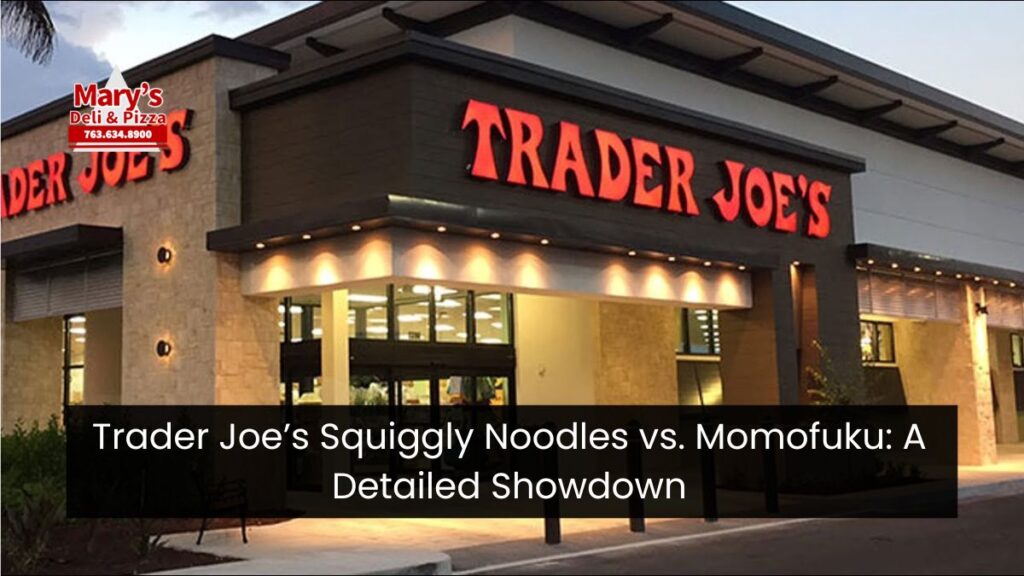In early 2023, Trader Joe’s introduced a new pantry staple that had shoppers and food lovers buzzing — the Squiggly Knife Cut Style Noodles. These noodles quickly gained attention across social media, with many fans customizing them with various sauces, toppings, and proteins.
With its affordable price tag of $4.99, Trader Joe’s noodles became a household favorite, even spurring resales at much higher prices online. But amidst the excitement, many began to compare them to a premium alternative — Momofuku’s noodles, created by celebrity chef David Chang.
While both products come from Taiwan, feature air-dried noodles, and share similar base ingredients — wheat flour, water, and salt — they differ in price, flavor, and texture. In this 1200-word review, I’ll dive deep into a side-by-side comparison of both noodle brands to see which one truly deserves a spot in your pantry.
Trader Joe’s Squiggly Knife Cut Style Noodles
Nutrition (Per 1 Noodle Pack + Sauce Packet):
- Calories: 310
- Fat: 2.5 g
- Sodium: 920 mg
- Carbs: 60 g
- Protein: 12 g
Trader Joe’s version of the squiggly noodle became an instant hit, partly due to its versatility and affordability. Each pack costs just $4.99 and comes with four servings of noodles.
To prepare, all you need is boiling water for about four minutes. The noodles come with a sauce packet that has a sesame-soy base, providing a lightly savory flavor.
Appearance: The noodles live up to their name — wavy, thick, and squiggly. The packet’s sauce may seem minimal, but a good mix will coat the noodles evenly. The dark brown soy sauce adds a touch of richness to the meal, though visually, it may appear more modest compared to pricier competitors.
Taste: The flavor is undoubtedly on the milder side, with light hints of soy and sesame. For some, this neutrality might make them a great base for customization. Many Trader Joe’s fans add a dash of Crunchy Chili Onion or Soyaki sauce to amplify the flavor.
The noodles themselves have a chewy texture that provides a nice bite, though not as doughy as others.
Momofuku Soy & Scallion Noodles
Nutrition (Per 1 Package):
- Calories: 320
- Fat: 3 g
- Sodium: 1,450 mg
- Carbs: 63 g
- Protein: 11 g
Momofuku is a renowned name in the culinary world, and its noodles reflect this prestige. Available for $11.99 for a pack of five, they’re more expensive than the Trader Joe’s counterpart but are marketed as a premium product.
Momofuku noodles are produced in partnership with A-Sha, a renowned noodle manufacturer in Taiwan known for its air-dried technique, which leads to fewer calories and a higher protein content compared to traditional instant noodles.
Appearance: Momofuku’s noodles are thinner than Trader Joe’s but still feature a slight wave. They come with two packets — a soy-sesame sauce and dried scallions, offering both flavor and visual appeal.
The dark brown sauce fully coats the noodles, creating an enticing dish. The addition of dried scallions adds an extra element, making it look and taste more gourmet.
Taste: The taste of Momofuku’s noodles is noticeably more pronounced than Trader Joe’s. The soy flavor is richer, and the dried scallions give the dish a sharpness that balances the savory sauce.
It’s clear that Momofuku’s product is designed to be eaten as is — without much need for additional ingredients. The texture of the noodles is less chewy but more doughy, making them a great vessel for absorbing the sauce.
Head-To-Head: Standard Versions
When it comes to the original, non-spicy versions of these noodles, Momofuku clearly takes the lead. While both products use soy and sesame as the main flavor profile, Momofuku delivers a richer, more complex taste, complete with added layers from the scallions.
The noodles, although thinner, hold up well to the sauce, and their doughy texture makes for a more enjoyable eating experience. On the other hand, Trader Joe’s noodles feel more like a blank canvas, requiring additional seasonings or toppings to reach their full potential.
Trader Joe’s Spicy Squiggly Knife Cut Noodles
Nutrition (Per 1 Noodle Pack + Sauce Packet + Sesame Paste Packet):
- Calories: 460
- Fat: 15 g
- Sodium: 700 mg
- Carbs: 66 g
- Protein: 15 g
Trader Joe’s recently spiced things up with a spicy version of their squiggly noodles, priced the same at $4.99 for four packs.
These noodles come with an extra sesame paste packet in addition to the spicy garlic sauce. The preparation remains the same, with the noodles boiling for four minutes and then mixed with the two packets.
Appearance: The spicy version looks almost identical to the original, but the sesame paste adds a bit more complexity in both texture and color. The sauce coats the noodles well, though the paste can sometimes clump together if not mixed properly.
Taste: The spicy version brings more flavor to the table compared to the regular noodles. The heat isn’t overpowering but leaves a pleasant tingle on the palate.
The sesame paste adds a subtle sweetness and nutty flavor, though some might find it a bit too strong. Overall, these noodles have more depth than the original, though still not as complex as the Momofuku options.
Momofuku Spicy Soy Noodles
Nutrition (Per 1 Package):
- Calories: 330
- Fat: 5 g
- Sodium: 1,350 mg
- Carbs: 63 g
- Protein: 11 g
Momofuku’s spicy version, priced at $11.99 for five packs, comes with a sauce that blends soy, chili, and sesame oil. These noodles offer a spicier kick without needing any extra garnishes.
Appearance: Similar to the original version, the spicy noodles look simple yet enticing. The sauce gives the noodles a deep brown hue, and the texture remains consistent.
Taste: These noodles pack a stronger punch compared to Trader Joe’s spicy noodles. The spice level is more prominent, leaving a lingering heat that elevates the soy and sesame flavors.
The chili enhances the overall richness of the dish, making it feel more like a restaurant-quality meal. The noodles, once again, absorb the sauce beautifully, creating a harmonious blend of textures and flavors.
Conclusion:
While Trader Joe’s Squiggly Noodles are a great budget-friendly option and offer a decent base for customization, Momofuku’s noodles reign supreme. The flavor profiles, especially the richness of the soy and scallion combination, and the overall texture of the noodles make Momofuku a clear winner in this showdown.
The price difference is justified by the superior taste and higher quality ingredients. For those seeking a more gourmet experience without breaking the bank, Momofuku is the way to go.






